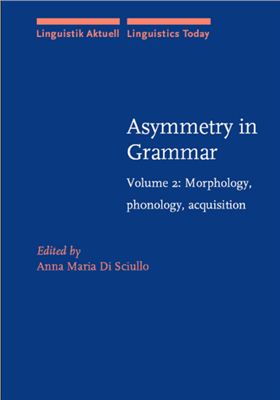Linguistik Aktuell / Linguistics Today
Pages: 316
Publisher: John Benjamins Publishing Company (2003)
Quality: good: pdf
Asymmetry in Grammar: Morphology, Phonology and Acquisition presents evidence that asymmetry, as a property of linguistic relations, is salient in grammar. The papers in morphology bring further evidence for the centrality of asymmetry in word-structure. It is shown that asymmetry is part of the inteal structure of functional constructs such as determiners and complementizers, as it is the case for lexical constructs. Further evidence is presented for the asymmetry of prefixes in verb structure. A typology of formal objects based on the distinction between maximal and minimal categories is formulated. It is proposed that Formal Complexity drives the change from synthetic to analytic expressions. The papers in phonology point to the fact that asymmetry is part of that linguistic dimension in terms of processes that eliminates symmetric relations, in terms of head-dependency relations, in terms of relative scope of the distinctive features in any inventory, in terms of universal principles in combination with certain language specific choices. Moreover, the papers on acquisition bring to fore experimental data that point to the same direction. The asymmetry of grammatical relations provides the form of the initial state of language that enables the child to cope with the poverty of the stimulus.
The collection includes papers in morphology by Anna Maria Di Sciullo, Angela Ralli, R?jean Canac-Marquis, Abdelkader Fassi Fehri, papers in phonology by Eric Raimy, Harry van der Hulst and Nancy Ritter, Glyne Piggott, Charles Reiss, Elan Dresher, and papers in acquisition from Maria Louisa Rivero and Magdalena Goledzinowska, and David Lebeaux.
ISBN: 90-272-2778-0
Pages: 316
Publisher: John Benjamins Publishing Company (2003)
Quality: good: pdf
Asymmetry in Grammar: Morphology, Phonology and Acquisition presents evidence that asymmetry, as a property of linguistic relations, is salient in grammar. The papers in morphology bring further evidence for the centrality of asymmetry in word-structure. It is shown that asymmetry is part of the inteal structure of functional constructs such as determiners and complementizers, as it is the case for lexical constructs. Further evidence is presented for the asymmetry of prefixes in verb structure. A typology of formal objects based on the distinction between maximal and minimal categories is formulated. It is proposed that Formal Complexity drives the change from synthetic to analytic expressions. The papers in phonology point to the fact that asymmetry is part of that linguistic dimension in terms of processes that eliminates symmetric relations, in terms of head-dependency relations, in terms of relative scope of the distinctive features in any inventory, in terms of universal principles in combination with certain language specific choices. Moreover, the papers on acquisition bring to fore experimental data that point to the same direction. The asymmetry of grammatical relations provides the form of the initial state of language that enables the child to cope with the poverty of the stimulus.
The collection includes papers in morphology by Anna Maria Di Sciullo, Angela Ralli, R?jean Canac-Marquis, Abdelkader Fassi Fehri, papers in phonology by Eric Raimy, Harry van der Hulst and Nancy Ritter, Glyne Piggott, Charles Reiss, Elan Dresher, and papers in acquisition from Maria Louisa Rivero and Magdalena Goledzinowska, and David Lebeaux.
ISBN: 90-272-2778-0

